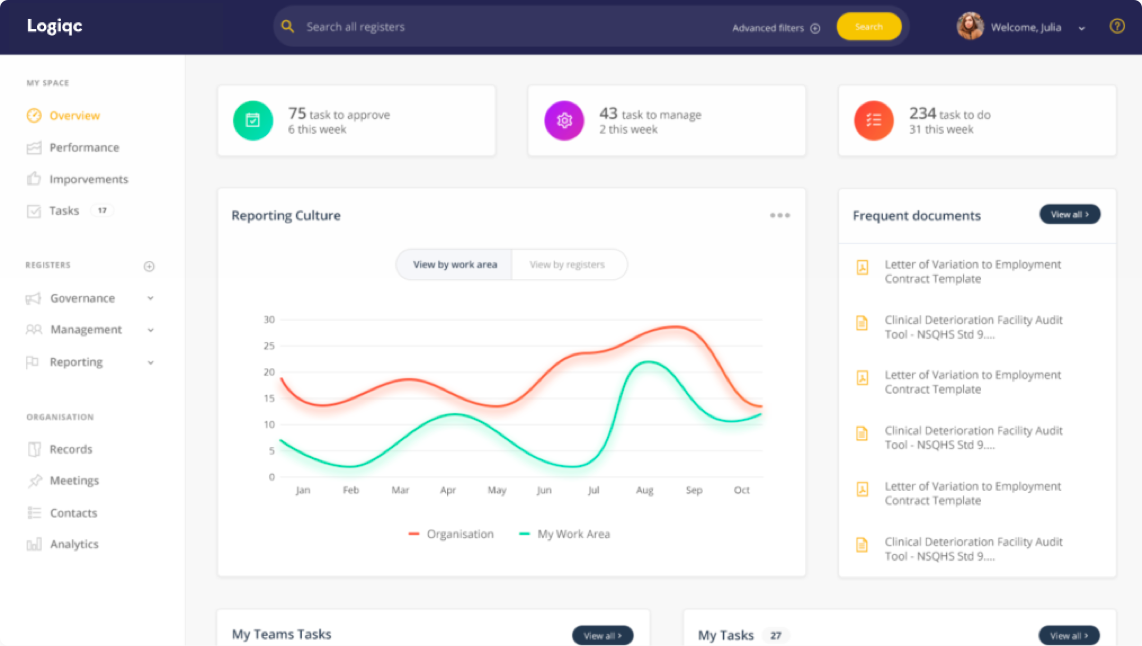In today’s healthcare and community service environments, data drives everything from clinical outcomes to compliance reporting. Yet too often, that data sits trapped in isolated systems.
“Integration is everything,” says Logiqc CTO Damien Turnbull. “For decades, healthcare has bought best-in-class software for specific jobs, one for records, one for billing, another for feedback. The result is a collection of brilliant but siloed systems. The future isn’t about finding one magic platform that does everything; it’s about building a digital ecosystem where these specialised systems can communicate seamlessly.”
That concept, known as interoperability, is rapidly becoming the foundation for safer, more efficient, and truly patient-centric care.
What Exactly Is a REST API?
For those outside the technical sphere, the term “API” can sound abstract. But as Turnbull explains, the principle is simple.
“A REST API is like a universal translator for apps and systems,” he says. “It lets one program talk to another, even if they’re built by completely different people, in different programming languages, or running on different machines.”
In essence, a REST API (short for Representational State Transfer Application Programming Interface) defines how systems communicate. It sets a shared language so that data can move freely, securely, and in real time between platforms.
Connecting the Dots with Logiqc
Within this connected landscape, the Logiqc REST API acts as the secure bridge linking safety and quality data across an organisation.
“Our API is designed to be the secure front door for all safety and quality data,” says Turnbull. “Logiqc becomes the central hub, and your other systems such as your patient management system, EHR, or website are the spokes. The API allows those systems to connect to the hub in a secure, structured way.”
That architecture enables powerful automation, take a hospital website’s patient feedback form as an example.
“The moment a patient hits submit,” Turnbull explains, “the website packages that data and makes a secure, authenticated call to the Logiqc API. We validate the source, check that the data is in the correct format, and instantly create a new record in the feedback register inside Logiqc. It all happens in milliseconds.”
The result is real-time, closed-loop reporting where data doesn’t just get transferred but triggers workflows and alerts. As Turnbull puts it, “That’s the difference between a data graveyard and a living, responsive system.”
Turning Data Into Strategy
Breaking down silos creates a single source of truth, something Turnbull calls “the holy grail” of organisational intelligence.
“It gives you data integrity,” he says. “Your leadership team can make critical decisions based on dashboards and reports they can actually trust. It also provides an auditable trail for every piece of safety data, which is invaluable for governance and accreditation.”
This consolidated dataset doesn’t just support compliance. It’s what enables more advanced analytics. “When your data is clean and connected,” Turnbull adds, “you can start to layer technologies like machine learning to identify and predict risks proactively.”
Empowering the Consumer Voice
Another powerful outcome of API integration is the ability to elevate patient and consumer feedback from anecdotal to actionable.
“An email is just a block of text that a human has to interpret,” says Turnbull. “An API call, on the other hand, can deliver feedback already categorised, tagged, and linked to a service or location. That turns the patient’s voice from a whisper in an inbox into a clear, measurable signal that can be tracked alongside your operational metrics.”
From Reactive to Proactive
According to Turnbull, real-time integration is also key to cultural change. “A reactive culture is often a symptom of batch processing, waiting until the end of the month to collate reports. An API-driven ecosystem gives you information as it happens. Managers can see trends emerging this morning, not next month. That’s what shifts organisations from reactive to proactive.”
Getting Started with Integration
For organisations ready to begin, Turnbull’s advice is to start small and strategic.
“The best first step is to pick one high-value problem to solve,” he says. “Don’t try to connect everything at once. Automating website feedback is often a great place to start because it’s a visible win that delivers immediate value.”
He adds that while Logiqc’s API is well-documented, most organisations will need a developer or technology partner to manage implementation. “We’re building a referral list of trusted integration partners who know our API suite. Reach out if you’d like to be connected with one.”
What’s Next for Connected Systems
Looking ahead, Turnbull sees two big frontiers: bidirectional integration and AI-driven insights.
“Right now, most of what we’re doing is about pushing data into a central system,” he says. “The next step is for that system to push insights and actions back out. Imagine closing an investigation in Logiqc and an API call automatically updates the patient’s record in the EHR.”
Then comes artificial intelligence. “When you layer AI on top of integrated data, the system won’t just tell you what happened, it’ll predict what’s likely to happen next. That’s where we’re heading, a fully connected, predictive, and learning health ecosystem.”
A Future Built on Connection
From automation to analytics, REST APIs are redefining what’s possible in healthcare and human services. With the Logiqc REST API, integration isn’t just about technology. It’s about creating a connected ecosystem that strengthens safety, quality, and trust.





